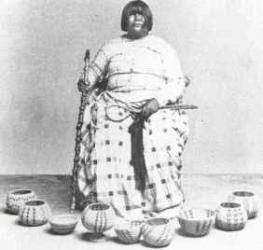Who's "the most famous basket weaver in the world"?
The answer is certainly debatable, but museum experts tend to agree that few can match the basketry legacy left by Dat So La Lee.
Who was she???
 Dat So La Lee was a Washoe native American born in Nevada sometime between 1825 and 1850. Her birth name was "Dabuda", meaning "Young Willow". Ironically, it was the use of willow which made her famous. Like most young western native American girls, Dabuda learned to weave baskets at a young age. However, she made her living as a laundress, and at about 45, she began to weave baskets exclusively. Dat So La Lee was a Washoe native American born in Nevada sometime between 1825 and 1850. Her birth name was "Dabuda", meaning "Young Willow". Ironically, it was the use of willow which made her famous. Like most young western native American girls, Dabuda learned to weave baskets at a young age. However, she made her living as a laundress, and at about 45, she began to weave baskets exclusively.
Marketing Dat So La Lee... meeting the Cohns
Prior to her basketweaving years, Dat So La Lee was married three times; her third husband was named Charlie Keyser, and at that time she went by the name of Louisa Keyser.
In 1895, she met merchandisers Abe and Amy Cohn. They immediately recognized her basketweaving as absolute works of art, unlike the typical "craft" basketry of others. Because of this, they became her patrons and documented each of her baskets woven from 1895 onward- about 120, although up to 300 may have been woven if one considers her life's work.
Her name also changed to Dat So La Lee at around this time.
Although the baskets that were documented bore the initials L.K. for Louisa Keyser on the paperwork, she was commonly known as Dat So La Lee. There are 3 or 4 theories about how the name came about. General consensus is that the name was white-derived, and definitely not an Indian name. In fact, it may have had something to do with marketing. The Cohns were known to have made up various stories about her life in order to get the prices that her baskets deserved. One such story was that she was the daughter of a Washoe chief and inherited the right to weave the sacred mortuary "day-gee-coop." The story says that after the Paiutes defeated the Washoe in war, they were prohibited from weaving these baskets and the Chief and Dabuda burned the ceremonial baskets, rather than allowing them to fall into Paiute hands. Not true.
DEGIKUP baskets
What IS true is that Dat So La Lee became famous for her degikup or "day-gee-coop" baskets. This type begins with a small, circular base, then coils up and out to a maximum circumference, which becomes smaller until the opening at the top is roughly the same diameter as the base. She wove these baskets for Cohn's Emporium for approximately thirty years until her death in 1925. During that time, she and her husband were given room and board in exchange for the baskets. They traveled with the Cohns and are said to have lived a comfortable lifestyle. I think we can agree that this kind of patronage takes the pressure off of an artist, and hence may have allowed her to weave freely creating designs of great beauty and variety.
Technique
Dat So La Lee's technique is called 3 rod coiling with uninterlocked stitches and an apex rod split. This is how she did it:
The foundation was three rods of willow twigs, and she wound this foundation with 3 kinds of sewing materials. The sewing material was wound around the foundation to cover it and carried up through the apex (top) rod of the previous round.
The creamy background color of her baskets was made by sewing with willow taken from just under the bark surface and cut to as narrow as a thirty-third of an inch!
Bracken fern roots were buried in mud for the black stitches, and also cut to this narrow width. The reddish tones were achieved with red birch bark. Her only cutting and scraping tool was a piece of glass!
Her Signature
Dat So La Lee was illiterate. One source is quoted as saying that she used her hand print, which was copyrighted, to certify bills of sale. The receipts included the hand print, a description of the basket, stitches to the inch, design, and time involved in its construction.
Dah So La Lee's Basketry Today
I first saw Dah SO La Lee's work at the Philbrook Museum in Tulsa in spring 2001. The Nevada State Museum also has a fine group of her work. (and other museums as well) Example: in 1978, three of her baskets were stolen from the Nevada State Historical Society. They were underground for 20 years, finally being traced to a dealer in Tucson, Arizona (who was not the thief, by the way). In February 1999, they were finally returned to the Nevada State Historical Society. Their value in 1999? $300,000 each. Yes, 5 zeros. No typo!
Final Resting Place
Dat So La Lee died in 1925 and is buried at the Stewart Cemetery on Snyder Avenue in Carson City, Nevada. Her grave reads "Myriads of stars shine over the graves of our ancestors."
To learn more about Dat So La Lee, and to see photos of her and her baskets, do an Internet search on "Dat So La Lee" or "Louisa Keyser".
Contents of this newsletter are copyright Linda Hebert 2001.
Linda Hebert
V. I. Reed & Cane
www.basketweaving.com
|